Day 2 :
Keynote Forum
Xiang Zhang
University of Cambridge, UK
Keynote: New concept of bioresorbable polymer-based ceramic hybrids for cardiovascular stent applications
Time : 09:00-09:25

Biography:
Xiang Zhang, Royal Society Industry Fellow of University of Cambridge, has over 34 years combined academia (17 years) and industrial (17 years) experience in advanced materials science and technology, an expert in polymer and polymeric hybrid materials science and technology. Prof. Zhang is also Head of the Lucideon Cambridge School of Advanced Materials and Head of Medical Materials and Devices. He is the author of three books “Inorganic Biomaterials”, “Inorganic Controlled Release Technology” and “Science and Principles of Biodegradable and Bioresorbable Medical Polymers - Materials and Properties”. As a materials scientist, he is passionate on “Science for Industry “and believes fundamental but applied sciences are the keys to industry R&D and problem solving. Prof. Zhang undertook his PhD and postdoctoral research at Cranfield University where he studied materials physics and nano/micro-mechanics and nano/micro-fracture mechanics of polymeric hybrid (organic and inorganic) materials. After spending a further four years on research for industrial applications, he was awarded an industrial fellowship at the University of Cambridge in 1995, where he carried out research on fundamental nanomechanisms of polymeric ductile to brittle transitions, which is first time in the world ever employing synchrotron SAXS, WAXS (wide angle and small angel X-ray scattering) to study in situ deformation and fracture down to nanometre scales, the results of which lead to completion of ductile to brittle transition theories in view of nano-mechanics and nano-fracture mechanics. Prof. Zhang’s industry experience was gained in leading international healthcare companies, where, as Principal Scientist/Technologist, his work covered almost all aspects of medical materials and devices from R&D and manufacturing support to failure analysis and QC. Prior to joining Lucideon, Prof. Zhang worked as Director of a technology company, in the field of nano-conductive materials and diagnostic medical devices.
Abstract:
This presentation will introduce new theories and industry practice for design and development of polymer-based ceramic hybrids. The evolution from pure polymer-based medical devices to polymer-based ceramic hybrids is to meet unmet market needs for better clinical performance over existing systems. There are many factors that can affect medical implant performance and, historically, most of them have been well studied, such as bioactivities and biocompatibility. In this presentation, new concept will be mainly addressing issue surround biomechanics, biofracture mechanucs and biofunctionality for design and development of new hybrid biomaterials for implant applications. It will report the principles on formulations for two type of the new systems. One family is of biodegradable and bioresorbable hybrids and 2nd is of non-biodegradable hybrids. It will be followed by design and development of medical devices in view of industry practice with clinical performance considerations of medical devices. The main topics covered in the presentation include: (a) New concepts and synthetic pathway of polymer-based ceramic hybrids; (b) Nano/Micro mechanics and nano/micro fracture mechanics; (c) Industry practice – two case studies will be used to demonstrate on how to design and develop polymer-based ceramic hybrid biomaterials and relevant processing technology for the applications of medical implants. Cardiovascular stent, as an example is traditionally made of metal such as Bare Metal Stents (BMS) or with drug coatings, i.e. Drug Eluting Stents (DES). There are, however, clinical complications associated with these technologies, such as, early stage restenosis, very late thrombosis and risk associated with revision surgery. In light of these challenges research focus has turned to the development of bioresorbable vascular scaffold (BVS) technologies.
We have developed new bioresorbable polymer-based ceramic stent that has been reinforced resorbable therapeutic cardiovascular stent to address the known limitations of cardiovascular technologies. We have developed a bioresorbable stent with intrinsic toughness for handling and deployment via balloon angioplasty, radial strength, controlled drug-release technology to suppress restenosis and surface functionalisation to promote endothelialisation to reduce risk of thrombosis. We present the novel synthetic polymer-ceramic composites developed as candidate stent-core materials, both their preparation and the characterisation of their mechanical behaviour, in vitro degradation will be presented.
Acknowledgement
Thanks to Prof. Ruth Cameron of University of Cambridge for assistance for materials characterization and Prof. Wenxin Wang of Vornia Ltd for synthesis some of the polymers used in the research. Thanks also to Dr Chris Lovell and Dr Mark Cresswell of Lucideon who have done most of the work in this presentation
Recent Publications
1. Science and Principles of Biodegradable and Bioresorbable Medical Polymers - Materials and Properties, 2016 by Elsevier
2. Inorganic Controlled Release Technology, 1st Edition - Materials and Concepts for Advanced Drug Formulation, 2015 pub. by Elsevier
3. Inorganic Biomaterials: Structure, Properties and Applications, 2014 pub. By Smithers Rapra
4. Polymer, 41 (2000) 3797-3807, X C Zhang, M F Butler and R E Cameron, “The Ductile – Brittle Transition of Irradiated Isotactic Polypropylene Studies Using Small Angle X-ray Scattering and Tensile Deformation”
5. Advanced Materials, 12 December 2015, Yongjiu Lei, Ruize Sun, Xiangcheng Zhang, Xinjian Feng, Lei Jiang, “Oxygen-Rich Enzyme Biosensor Based on Superhydrophobic Electrode”
6. Polymer, 41 (2000) 3797-3807, X C Zhang, M F Butler and R E Cameron. “The Ductile – Brittle Transition of Irradiated Isotactic Polypropylene Studies Using Small Angle X-ray Scattering and Tensile Deformation”
Keynote Forum
Nikolay Gerasimchuk
Missouri State University, USA
Keynote: Multifunctional materials stemming out of coordination compounds
Time : 09:25-09:50

Biography:
Nick Gerasimchuk is Full Professor of Inorganic Chemistry at Missouri State University (USA). His research interests and expertise lay in the following areas: 1) the 1D coordination polymers as cytotoxic NIR emitters for theranostic applications; 2) mixed valence compounds; 3) novel antimicrobials based on silver and antimony oximates; 4) physical methods of investigation of inorganic and coordination compounds, including small molecules crystallography of inorganic and coordination compounds; 5) equipment design for synthetic inorganic/materials chemistry.
Abstract:
The definition is: “materials science is an interdisciplinary field concerned with the understanding and application of the properties of matter.” This area is dedicated to study of connections between the underlying structure of a material, its properties, its processing methods, and its performance in intended applications. Classic understanding of materials traditionally limits them to metals and their alloys [uses in: construction, catalysis, electric/conductance, magnetism], a variety of oxides [refractory materials, catalysts, ceramics/cements, quartz, conductance/semiconductance], thermally stable salts [silicates (including glass), phosphates, binary halides and halcogenides [optical materials, semiconductors], etc. Typically those classic materials are produced in large quantities from thousands- to multi-tons quantities.
However, during the last two decades a new type of chemical compounds vigorously claimed a well-deserved place in the vast world of materials. These are coordination compounds. There are two large sub-classes of the Werner-type complexes and organometallic compounds (Scheme 1) with principally very different chemical bonding in them. The first one adopts predominantly ionic/donor-acceptor type, while the latter represent covalently bonded species containing direct metal-carbon bond. Numerous coordination compounds of both types were employed as precursors for materials. Most common transformation of complexes includes their thermal decomposition leading to a product/material with desired properties for a specific application. However, only Werner-type complexes can be used as materials because of their stability at ambient conditions. Most of the organometallic species still are intrinsically unstable towards moisture and oxygen.
Applications of numerous complexes as materials (and specifically those as multifunctional materials) are reviewed in current presentation. These applications include usage of numerous Werner- type complexes in a variety of MOFs (gas sorption, purification of compounds, delivery), non-linear optical materials (second harmonic generation and optical limiters), catalysts, sensors and indicators, functional supramolecular materials, light harvesting/converting materials, molecular electronics.
Recent Publications
Dr. Gerasimchuk authored and co-authored 112 publications and 7 patents on useful properties of a variety of the obtained compounds. Some representative works are shown below:
1. Cheadle C, Ratcliff J, Berezin M, Pal’shin V, Nemykin V.N., Gerasimchuk N. (2017) Shortwave infrared luminescent Pt- nanowires: a mechanistic study of emission in solution and in the solid state. Dalton Transactions: 46(39), 13562-13581.
2. He S, Toukrakis G, Berezin O, Gerasimchuk N, Zhang H, Zhou H, Izraely A, Akers W.J, Berezin M.Y. (2016) Temperature-dependent shape-responsive fluorescent nanospheres for image guided drug delivery.” J. Mater. Chem. C, 4, 3028-3035.
3. Gerasimchuk N. (2014) Synthesis, Properties, and Applications of Light-Insensitive Silver(I) Cyanoximates. Eur. J. Inorg. Chem. 4518– 4531.
4. Gerasimchuk N, Berezin M. Near Infrared Emitters. US Patent Application No. 15/001,023; January 19, 2016.
Keynote Forum
Geoffrey Mitchell
CDRSP-IPLeiria, Portugal
Keynote: Multiscale 3D printing with polymers
Time : 09:50-10:15

Biography:
Geoffrey Mitchell is Professor and Vice-Director of the Centre for Rapid and Sustainable Product Develop at the Institute Polytechnic of Leiria. Geoffrey Mitchell is passionate about direct digital manufacturing (DDM) which enables products to be manufactured directly from a digital design without the need for specialist tooling or moulds and the development of novel materials to support the emerging technologies. He is fascinated by the opportunities that arise from merging electrospinning in to the family of DDM technologies. He brings a wealth of experience working with polymer based materials both natural and synthetic. He is particularly interested in the scales of structure present in all materials and especially biopolymers. He has developed and made extensive use of x-ray and neutron scattering methods coupled to computational molecular modelling and electron microscopy techniques.
Abstract:
3D printing is part of the family of Direct Digital Manufacturing processes in which a part is prepared with a particular external form defined in a digital manner without the use of complex tooling or moulds. Such an approach is revolutionising manufacturing. It creates a new paradigm for design and in aerospace, the concept is already in use to prepare parts such as turbine blades with shapes which hitherto were impossible. The fact that each part can have an individual design identifies that this technology has much to offer to medical devices. Now of course a part is not just defined by its external form but also by the microscale structure which develops in the part during the manufacturing process. In this presentation we review the materials and molecular mechanisms available to deliver controlled and defined morphology during 3D printing technology and how this influences properties. We present a novel methodology for delivering orthogonal control of the semi-crystalline morphology of poly(e-caprolactone) in biomedical devices. We take examples from recent research at CDRSP and consider its impact on scaffolds for tissue engineering.
This work is supported by the Fundação para a Ciência e a Tecnologia (FCT) through the Project references: UID/Multi/04044/2013; PAMI - ROTEIRO/0328/2013 (Nº 022158), MATIS (CENTRO-01-0145-FEDER-000014 – 3362 and UC4EP PTDC/CTM-POL/7133/2014)
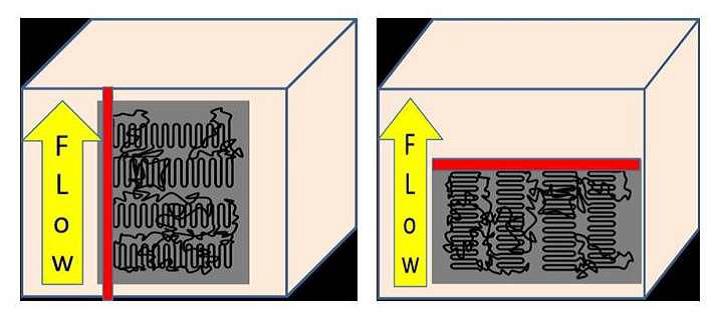
Recent Publications
1. G.R.Mitchell and Ana Tojeira editors “Controlling Controlling the Morphology of Polymers: Multiple Scales of Structure and Processing." Springer 2016 ISBN 978-3-319-39320-9
2. G.R.Mitchell, Donatella Duraccio, Imran Khan, Aurora Nogales, R.H.Olley ‘Templated Crystallisation in Polymer Nanocomposites’ in “Controlling the Morphology of Polymers: Multiple Scales of Structure and Processing." Springer 2016 ed G.R.Mitchell and A.Tojeira ISBN 978-3-319-39320-9
3. G.R.Mitchell, F.J.Davis, R.H.Olley and S.Wangsoub ‘Directing the Crystallisation of Polymers using nanoparticles of sugar alcohol derivatives’ in “Controlling Controlling the Morphology of Polymers: Multiple Scales of Structure and Processing." Springer 2016 eds G.R.Mitchell and A.Tojeira ISBN 978-3-319-39320-9
4. Geoffrey R Mitchell and Robert H Olley Orthogonal templating control of the crystallisation of poly(ε-caprolactone) Polymers, 2018, 10(3), 300; doi:10.3390/polym10030300
5. Ana Tojeira and G.R.Mitchell “Controlling Morphology in 3-D Printing” in “Controlling Controlling the Morphology of Polymers: Multiple Scales of Structure and Processing." Springer 2016 ISBN 978-3-319-39320-9
- Sessions: Materials Science and Engineering | Metals, Mining, Metallurgy and Materials
Location: Linate

Chair
Floricica Barvinschi
Politehnica University Timisoara, Romania

Co-Chair
Nobufumi Ueshima
Tohoku University, Japan
Session Introduction
Arnaud Caron
KoreaTech, Republic of Korea
Title: Thermodynamic effects on metals tribology at the nanometer scale
Time : 10:15-10:35

Biography:
Arnaud Caron is a materials scientist with expertise in the multi-scale mechanical behavior of materials, surfaces and micro-components. Since 2015 Arnaud Caron is Assistant Professor in the School of Energy, Materials and Chemical Engineering at KoreaTech, Republic of Korea. Arnaud Caron obtained his engineering degree in Materials Science in 2004 from the University of Saarland, Germany and was awarded with the Schiebold Medal. In 2009 he earned his doctoral degree in Materials Science from the University of Saarland, Germany. From 2006 to 2015 Arnaud Caron worked as a research associate at the Institute of Micro- and Nanomaterials of the University of Ulm, Germany, the WPI-Advanced Institute of Materials Research, Japan and the Leibniz – Institute for New Materials, Germany.
Abstract:
Understanding and controlling the surface mechanical behavior of materials is crucial for the development of new devices. We have investigated the effects of chemistry on the friction and wear behavior of face centered cubic metal and alloy surfaces in contact with a single asperity by friction force microscopy. In the low load regime below 10 nN, we show that sliding friction behaviors of different metallic couples is governed by their thermodynamic affinity. Comparing the friction behavior of miscible and immiscible couples we find that in the first case friction is governed by adhesion while the friction force is almost independent on the normal load. In the latter case of immiscible couples, adhesion is found to be low and the friction force increases with the normal load. At larger loads, friction and wear of pure fcc metals is found to scale with the ratio of the surface energy to the hardness, which describes both contributions involved into the ploughing process: the resistance of the material to flow ahead of a penetrating asperity and the formation of a fresh surface behind the asperity. Finally, we show how the tribological response of a Ag-Cu nano-eutectic alloy surface is affected to its solidification velocity. It is found that both the microstructural length-scale and the solubility of both elements into one another determine the wear response of this alloy.
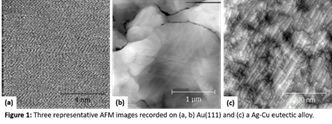
Recent Publications
1. Ko HE, Kwan SG, Park HW, Caron A (2017) Chemical effects on the sliding friction of Ag and Au(111). Friction; doi.org/10.1007/s40544-017-0167-5.
2. Kang SJ, Rittgen KT, Kwan SG, Park HW, Bennewitz R, Caron A (2017) Importance of surface oxide for the tribology of a Zr-based metallic glass. Friction 5: 115-122; doi.org/10.1007/s40544-017-0149-7.
3. Caron A (2016) Quantitative hardness measurement by instrumented AFM-indentation. Journal of Visualized Experiments 117; doi: 10.3791/54706.
4. Caron A, Bennewitz R (2015) Lower Nanometer-scale size limit for the deformation of a metallic glass by shear transformations revealed by quantitative AFM indentation. Beilstein journal of nanotechnology 6:1721-1732; doi: 10.3762/bjnano.6.176.
5. Caron A, Louzguine-Luzgin DV, Bennewitz R (2013) Structure vs chemistry: friction and wear of Pt-based metallic surfaces. ACS Applied materials and interfaces 13:11341-11347; doi:10.1021/am403564a.
Nobufumi Ueshima
Tohoku University, Japan
Title: Relationship between grain distribution and strain localization in Cu-Al alloys
Time : 10:50-11:10

Biography:
Nobufumi Ueshima received his PhD from Osaka University in 2014. He subsequently joined the faculty of Department of Metallurgy, Tohoku University, as an assistant professor. He has his expertise in computational material science, and focuses on the application of Phase-Field Modeling and KWN modeling for simulating precipitation kinetics of second phase in metallic materials. He has expanded his expertise to plastic deformation of metals after years of experience in research in Tohoku University. He also focuses on relationship between microstructure and plastic deformation in metallic materials. He has developed a methodology to observe the relationship between grain distribution and strain distribution to investigate microstructure-deformation relationship.
Abstract:
It has been highly demanded to miniaturize lead frames, sockets and any kind of connecting element made of copper or its alloys. Miniaturization increases the ratio of grain size to parts size. In such a case, individual grain size and orientation effect on the deformation behavior becomes significant, which causes ununiform deformation and decrease in formability. To understand the mechanism of the ununiform deformation in detail, strain localization during tensile test of oligo-crystalline Cu-Al plate has been investigated.
Cu-Al alloys were melted by induction furnace and cast into stainless steel mold. Dog-bone specimens were cut from the cast alloys. The cooling rate after casting was controlled to obtain various grain sizes, which enables us to see the effect of grain distribution on strain localization in visible scale by optical microscopy. Crystal orientation of the grains was analyzed by EBSD. A random pattern was painted on the surface of the specimen and the painted surface was recorded during tensile test to analyze strain distribution by digital image correlation (DIC) method.
Figure 1 shows the equivalent strain distributions of the reduction section during tensile test. Nominal tensile strain calculated from DIC analysis was 0.1. Strain was localized in specific grains before reaching its highest strength. Schmid's factor of the grains was analyzed. We found that the strain does not always localize at high Schmid's factor grains. When high Schmid's factor grain is surrounded by low Schmid's factor grains, the high Schmid's factor grain cannot deform largely. In contrast, strain was localized relatively low Schimid's factor grains chained over the width of the specimen. In such a case, interlocking among grains seems to be relatively weak since the edge of the specimen can move freely, which may be the reason for the strain localization.

Figure 1: Strain Distribution of oligo-crystalline Cu plate at 0.1 of tensile strain. The black lines show the grain boundaries measured by EBSD. The numbers are grain index. We can see strain localization at grain 4 and 6.
Recent Publications
1. Ueshima N, Maeda T, Oikawa K (2017) Effect of Cu addition on precipitation and growth behavior of MnS in silicon steel sheets. Metall. Mater. Trans. A 48:3843-3851.
2. Ueshima N, Liu XT, Utsumi H, Chiyokubo T, Horio K, Oikawa K (2017) Influence of Cu and Mg addition on age-related deterioration in strength and creep behavior of Zn-12Al die casting alloy, Int. J. Mater. Res. (formerly Z. Metallkd.) 108:151-154.
3. Ueshima N, Yoshiya M, Yasuda H, Fukuda T, Kakeshita T (2015) Numerically-quantified two dimensionality of microstructure evolution accompanying variant selection of FePd. Mater. Res. Exp. 2:076502(13pages).
4. Ueshima N, Yoshiya M, Yasuda H, Fukuda T, Kakeshita T (2014) Impact of interplay between magnetic field, transformation strain, and coarsening on variant selection in L10-type FePd. J. Appl. Phys. 115:073501(10pages).
5. Ueshima N, Shikatani T, Yoshiya M, Yasuda H (2013) Effect of Spatial Distribution of Local Magnetization on Microstructure Formation in L10-type Ferromagnetic Alloys under External Magnetic Field. Trans. Mater. Res. Soc. Jpn. 38:673-676.
Floricica Barvinschi
Politehnica University Timisoara, Romania
Title: Numerical modeling of transport phenomena during the solidification of materials
Time : 11:10-11:30

Biography:
Floricica Barvinschi is Associate Professor at Politehnica University Timisoara, Romania. She has a PhD thesis in heat transport numerical modeling during the growth of CaF2 and BaF2 crystals by VB method. A part of her PhD thesis was conducted by Prof.dr. Thierry Duffar, INP Grenoble, at that time engineer at CEA Grenoble, France. Continuing a very good collaboration, Floricica .Barvinschi has been invited several times to the CEA Grenoble and INP Grenoble for scientific researches and/or for teaching.
Abstract:
Statement of the Problem: A method for the Vertical Bridgman (VB) solidification of InSb in a silica ampoule is modeled with COMSOL Multiphysics software, using time-dependent thermal conditions. Axial-symmetric numerical simulations of temperature, velocity field in the melt, under normal gravity, and capillarity at the melt-gas-crucible interface resemble those used in an induced pressure difference dewetting VB configuration. The VB technique has some drawbacks that are linked to the use of a crucible in intimate contact with the growing crystal. Methodology & Theoretical Orientation: In order to avoid the sticking of the crystal on the crucible, which can result in crystal or crucible breakage, a pressure difference is built up inside a sealed growth ampoule by a temperature variation. Detached growth is a small gap between the growing crystal and the crucible wall. The contact-free growth reduces mechanical stress in the crystal, resulting in a reduction of the defect density. Findings: In the present paper we extend our previous steady-state model by including the calculation of the energy, momentum and mass transport, plus the interfacial phenomena at the melt-gas-crucible interface, under normal gravity, while applying a time dependent step-type temperature distribution on the outer part of the crucible. Conclusion & Significance: Several systematically studies on this subject have been reported during time, both experimental and numerical. In order to model the flow of two different, immiscible fluids, where the exact position of the interface is of interest, we have applied the phase-field method. The purpose of this study is to include in a single model the transport phenomena (energy, momentum, mass) and the interfacial phenomena at the melt-crystal-crucible and respectively melt-gas-crucible interfaces. All these new models were developed numerically. The validation of modeling was made by comparing Lamine Sylla`s results, reported in his PhD thesis.

Figure 1: Vertical Bridgman model and transient boundary conditions.
Recent Publications
1. Barvinschi P, Barvinschi F (2011) Coupled Heat Transfer and Fluid Dynamics Modeling of InSb Solidification. AIP Conference Proceedings 1387:190-197.
2. Sylla L (2008) Etude Experimentale et Thermodynamique du Procédé de Démouillage Appliqué aux Semiconducteurs. PhD Thesis INP Grenoble France.
3. Duffar T (Ed.) (2010) Crystal Growth Processes Based on Capillarity. Czochralski. Floating Zone. Shaping and Crucible Techniques J. Wiley & Sons Ltd. Chichester UK.
4. Barvinschi B, Barvinschi P (2015) Numerical investigation of crystal growth in a vertical Bridgman configuration using a mushy zone model. JOAM 17 (3-4): 431-438.
5. Gallien B, Sylla L, Bengulescu M, Barvinschi F, Duffar T (2013) Study of crystal-crucible detachment: GaSb in SiO2. CrystEngCom 15: 2329-2336.
6. Stelian C, Yeckel A, Derby J J (2009) Influence of thermal phenomena on crystal reattachment during dewetted Bridgman growth. J.Cryst.Growth 311: 2572-2579.
Acknowledgments: This work was supported in part by the strategic grant POSDRU/21/1.5/G/13798, inside POSDRU Romania 2007-2013, co-financed by the European Fund-Investing in People.
Alberto Monsalve
Universidad de Santiago de Chile, Chile
Title: Influence of temperature on mechanical properties of a Fe-22Mn-0,6C TWIP steel
Time : 11:30-11:50

Biography:
Alberto Monsalve G. has his expertise in steel processing and materials characterization. He is a full time teacher in Metallurgical Department in Universidad de Santiago de Chile and part time teacher in Academia Poitécnica Aeronáutica and Universidad Técnica Federico Santa María, Chile. He works for local industry in the solution of failure problems and give supervision to different postgraduates’ programs in Chile and other countries.
Abstract:
The objective of the present study is to analyze the microstructure and mechanical properties of a TWIP steel at different temperatures. For this purpose, tensile tests were performed in a Fe-22Mn-0.65C TWIP (Twinning-induced plasticity) steel in a temperature range between 25 °C and 400 °C. The microstructure after deformation was characterized via optical microscopy. It was observed that the microstructure consists of mainly deformation twins at low temperatures, whereas dislocation bands are the predominating feature at high temperatures. The yield stress, ultimate tensile strength, total elongation, strain hardening index and the area reduction were measured at different temperatures. The analysis of mechanical data suggests a transition of deformation mechanism from twinning at low temperature to dislocation slip at high temperatures. The work hardening rate and area reduction variations with temperature are discussed and correlated to the decrease of twinning contribution to the deformation mechanism. The role of other process, such as dynamic strain aging and precipitation hardening, are discussed. A thermodynamic-based description for the dependence of Yield stress with temperature was developed, suggesting two acting work hardening mechanisms. This is consistent with the computed activation energy for each mechanism. The stacking fault energy (SFE) was computed by means of Olson and Cohen model, at different temperatures finding that at temperatures higher than 325°C, dislocation glide was the predominant deformation mechanism, which is in accordance with experimental results. Twinning-volume fraction (TVF) in samples tested at different temperatures were computed, finding a decrease in TVF as testing temperatures increases, which in agreement with previous experimental features.
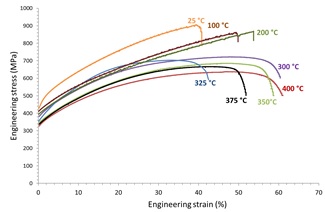
Recent Publications
1. B. De Cooman, Y. Estrin, S. Kim (2018) Twinning-induced plasticity (TWIP) steels. Acta Materialia 142: 283-362.
2. A. Saleh, A. Gazder (2016) A re-evaluation of “The micromechanics of twinning in a TWIP steel”. Materials Science and Engineering A 649:184-189.
3. E. Galindo-Nava, P. Rivera-Díaz-del-Castillo (2017) Understanding martensite and twin formation in austenitic steels: A model describing TRIP and TWIP effects. Acta Materialia 128:120-134.
4. B. De Cooman, O. Kwon, K. Chin (2012) State-of-the-knowledge on TWIP steel. Materials Science and Technology 28:513-527.
5. O. Bouaziz, S. Allain, C. Scott, P. Cugy, D. Barbier (2011) High manganese austenitic twinning induced plasticity steels: A review of the microstructure properties relationships. Current Opinion in Solid State and Materials Science 15:141-168.
Felix Gunkel
RWTH Aachen University, Germany
Title: Atomic defect-engineering at complex oxide surfaces and interfaces for electrolysis, sensing, and electronics applications
Time : 11:50-12:10

Biography:
Felix Gunkel is a young investigator based at Institute of Electronic Materials (IWE2) at RWTH Aachen University, Germany. His research interests comprise thermodynamics and solid state chemistry of complex oxides on the nanoscale. His current work addresses tailored functionality of crystal defects in oxides for nano-electronic devices, energy applications, and gas sensors.
With background is fundamental and applied physics, Dr. Gunkel started his scientific career at Institute of Solid State Physics, Forschungszentrum Jülich, Jülich, Germany in 2010. He received his PhD from the faculty of electronic engineering at RWTH Aachen University in 2013. After continuing his scientific work in his postdoctoral career at Stanford University and Forschungszentrum Jülich, he is now leading a research team at RWTH Aachen University, Germany, with a research focus of thermodynamic engineering of device properties and material functionality on the nanoscale.
Abstract:
Perovskite oxides exhibit a plethora of fascinating electronic material properties covering an exceptionally wide range of phenomena in solid state and surface physics. This has led to tremendous efforts to functionalize these materials in applications for energy technology, gas sensing, and electronics. Layered in an atomically defined epitaxial heterostructures and superlattices, diverse properties of perovskites can be combined on the nanoscale level. In such structures, even new functionality can arise at interfaces of layered materials, exhibiting properties that are absent in the bare bulk materials.
In our approach, we utilize atomically-defined layer growth to obtain desired material properties. However, on top of that, we employ thermodynamic engineering of crystal defects as a unique approach to functionalize material properties at surfaces and interfaces: Even at material synthesis conditions close to perfection, device properties are often determined by imperfection, hence, by lattice disorder and crystal defects. As we discuss, we can intentionally control defect structure in nanoscale devices, by developing and utilizing thermodynamic routes to trigger surface and interface reactions in confined systems.
While historically defects were seen as something to be avoided, a change of paradigm is required in the field of complex oxides today: In these materials, we can promote functionality, such as metallicity in nominally insulating compounds, by atomic defect-management. Therefore, rather than avoiding defect formation, it is an essential necessity to control and to utilize defect formation in oxides on the nanoscale.
Here, we discuss fundamental aspects of lattice disorder effects in bulk oxides, and elaborate the special character of defect formation in thin films, surfaces and interfaces. Focusing on SrTiO3 as a perovskite model system, we will crosslink fundamental perspectives on lattice disorder to actual applications, addressing different examples, such as resistive switching memories, high-mobility electron gases and induced magnetism, oxygen sensors, and electro-catalysts.
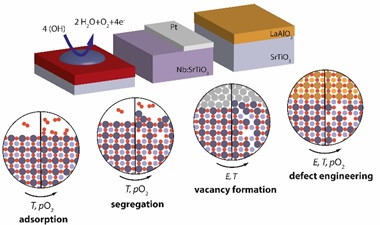
Recent Publications
1. F. Gunkel, et al., “Defect-control of anomalous and conventional electron transport in NdGaO3/SrTiO3 heterostructures”, Physical Review X, 6, 031035 (2016)
2. F. Gunkel et al., “Ordering and phase control in epitaxial (Pr,Ba)CoO3-ï¤ catalysts for oxygen evolution reaction”, ACS Catalysis 7 (10), 7029–7037 (2017)
3. M. Andrä et al., “Oxygen partial pressure dependence of space charge formation in donor doped SrTiO3”, APL Materials 5, 056106 (2017)
4. F. Gunkel et al., “Mobility modulation and suppression of defect-formation in two-dimensional electron systems by charge transfer management”, ACS Applied Materials & interfaces 9 (12), 10888 (2017)
5. R. Meyer et al., “Dynamics of the metal-insulator transition of donor-doped SrTiO3”, Physical Review B 94, 115408 (2016)
6. F. Gunkel et al., “Defect concentration profiles at complex oxide interfaces”, Physical Review B 93, 245431 (2016)
Lev Rapoport
Holon Institute of Technology, Israel
Title: Deformation microstructure of surface layers of Ag, Cu, Ni and Al under friction in lubricant conditions
Time : 12:10-12:30

Biography:
Rapoport is the Head of the Center for Materials Engineering and the Laboratory of Tribology at the Holon Institute of Technology. Friction and wear research of nanomaterials is known both nationally and internationally. Friction and wear properties of fullerene-like nanoparticles were studied at first in the laboratory of Prof. Rapoport. Prof. Rapoport is a principal investigator in several research grants sponsored by the Israel Ministry of Science, the Bi-national Israel- USA and Germany-Israel Funds. Prof. Rapoport is the author more than 100 publications. He is Vice-President of the Tribology Council in Israel.
Abstract:
Friction and wear are the crucial problems affecting the life time of moving mechanical parts. The main goal of this work is to study: the evolution of the microstructure after friction with lubricant of four fcc metals (Ag, Cu, Ni and Al and the effect of stacking fault energy (ï§SFE) on grain size and wear loss. Friction surfaces were carefully examined with a field emission scanning electron microscope. The cross sectional TEM lamellae were prepared from the pins using a focused ion beam (FIB). Cross-sectioning of the specimens was done in the longitudinal and transverse directions (parallel and perpendicular to direction of friction).Deformation twinning followed by a limited recovery within a surface of Ag led to formation of relatively thick top layer of ultra-fine equiaxial grains. Surface regions of Cu and Ni samples consisted of inhomogeneous microstructure with wide range of grain sizes. With a depth lamellar structure was formed parallel to direction of friction for Ag, Cu and Ni. Subdivision of grains into subgrains with high dislocation density is clearly observed within a lamellar structure. Steady state values of grain size, ds and hardness, Hs after friction in lubricant conditions are explained by a balance between hardening and dynamic recovery in surface layers strongly depending on the gSFE and temperature.
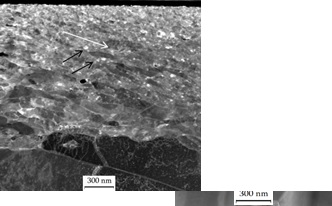
Typical HAADF STEM images of Ag presenting general view of deformation microstructure with a gradient of grain size. The white arrow shows direction of friction. Black arrows show the pores in top layers.
Luis Manuel Angelats Silva
Universidad Antenor Orrego, Peru
Title: Flaxseed mucilage as an eco-friendly inhibitor for ASTM A335 P11 steel in HCl
Time : 12:30-12:50

Biography:
Luis M. Angelats Silva has experience in electrochemical corrosion of metallic materials. Within its diverse research in materials science and technology, it is currently looking for alternatives to improve corrosion resistance by using natural polysaccharides as non-toxic inhibitors for human health and the environment. His experience in electrochemical studies has allowed him to develop diverse methods and/or techniques that allow him to evaluate, through accelerated corrosion tests, the efficiency of inhibition of these polysaccharides in alloy steels widely used in high temperature pipes.
Abstract:
Statement of the Problem: The high efficiency of corrosion inhibition of synthetic organic inhibitors in the industries of chemical cleaning, acid etching, acidification of oil wells and acid desalination is well recognized. However, most of these inhibitors are toxic to the environment and human health. This has forced to look for more secure corrosion inhibitors called "green corrosion inhibitors" due to its non-toxicity, biodegradability and low cost. In recent years, the use of natural polysaccharides as an environmentally safe corrosion inhibitor has received special attention. For this reason, the present study, evaluates the mucilage of Linum usitatissimum, which contains a high content of polysaccharides, as a corrosion inhibitor of ASTM A335 grade P11 steel in HCl -1.0 M. Methodology & Theoretical Orientation: All the corrosion tests were carried out at least in triplicate to evaluate the reproducibility of the same, by means of the techniques of: weight loss tests, Tafel extrapolation, resistance to linear polarization, electrochemical impedance spectroscopy and electrochemical frequency modulation. For the electrochemical tests the Gamry Reference 3000 potentiostat was used. Figure 1 shows part of the tests carried out at 65°C. Findings: Considering the five techniques, it was observed that the average inhibition efficiencies for a dosage of 0.5g/L of mucilage were 77.3%, 81.2% and 88.6% at temperatures of 25ºC, 45ºC and 65°C, respectively. Higher dosages only generated a slight increase in inhibition efficiency. Additionally, it was also found that an increase in temperature produced an increase in the adsorption constant and a decrease in the standard free energy of adsorption. The standard enthalpy of adsorption was positive and the apparent activation energy decreased with increasing mucilage concentration. Conclusion & Significance: From the results, we conclude that the Linum mucilage acts as a good corrosion inhibitor of P11 steel in HCl-1.0 M. Its efficiency increased with the increase in temperature. Likewise, it was determined that the adsorption of mucilage on steel P11 occurs through a chemical adsorption, acting as a mixed type inhibitor.
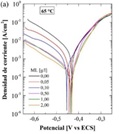
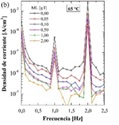
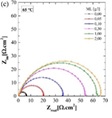
Figure 1. Corrosion tests of P11 steel in HCl-1.0 M containing different concentrations of Linum mucilage (g/L) at 65ºC. (a) Potentiodynamic polarization curves, (b) Intermodulation spectra and (c) Nyquist diagram.
Recent Publications
1. Finšgar, M., Jackson, J. (2014) Application of corrosion inhibitors for steels in acidic media for the oil and gas industry: A review. Corrosion Science, v. 86:17–41.
2. Sharma, S.K., Sharma, A. (2011) Green corrosion inhibitors: status in developing countries. In: Sharma S.K. (ed.) Green corrosion chemistry and engineering, Wiley–VCH, Weinheim, p. 157-180.
3. Peter, A., Obot, I.B., Sharma, S.K. (2015). Use of natural gums as green corrosion inhibitors: an overview. International Journal of Industrial Chemistry, 6:53-164.
4. Bentrah H, Rahali Y, Chala A. (2014) Gum Arabic as an eco-friendly inhibitor for API 5L X42 pipeline steel in HCl medium. Corr. Sci. 82: 426-431.
5. Roy P, Karfa P, Adhikari U, Sukul D. (2014) Corrosion inhibition of mild steel in acidic medium by polyacrylamide grafted Guar gum with various grafting percentage: Effect of intramolecular synergism. Corr. Sci. 88: 246-253.
Sezai Elagoz
Cumhuriyet University, Turkey
Title: InGaAs/InAlAs SLs via MOCVD for QCL Applications
Time : 12:50-13:10

Biography:
Sezai Elagoz is currently a full Professor in the Department of Nanotechnology Engineering and the director of the Nanophotonics Research and Application Center at Cumhuriyet University, Turkey. He received his M.Sc and Ph.D. degrees from University of Michigan in 1993. He has published more than 60 peer-reviewed articles and his currently research interest includes semiconductor crystal growth for quantum cascade lasers, high brightness InGaN/GaN based light emitting diodes, high efficiency tandem solar cells and short wave infrared detectors.
Abstract:
InGaAs/InAlAs superlattices (SLs) are very attractive and suitable for QCL applications due to the availability of lattice matching on InP substrate and large conduction band offset. When InxGa1-xAs and InyAl1-yAs compounds are lattice matched to InP substrate, this allows fabricating QCL devices with an emission wavelength at λ>4µm. Similarly, to go larger wavelengths, the same materials can be used by utilizing a technique known as strain-balancing to overcome the difficulties arise from lattice mismatch. Precise thickness control, alloy composition control and repeatability of the SLs are the most critical issues to be dealt with in growth studies to obtain the desired device structures. The thinnest layer thickness is a few monolayers and the device performance is quite sensitive to interface roughness. Molecular beam epitaxy (MBE) is the generally preferred growth technique due to the requirement of having very thin layers with sharp interfaces. However, QCL also includes thick layers such as claddings for which MOCVD suits the best. For these reasons, it is worth efforts to find a way to grow the whole structure via MOCVD. Using special growth conditions and smaller mass flow controllers (MFCs) it is possible to precisely control the gas flow quantity dilution and injection of metalorganic sources. Transmission Electron Microscope (TEM), Scanning Tunneling Electron Microscope (STEM) and similar techniques are widely used to determine the exact thickness of epitaxially grown SLs. However, these techniques are destructive, relatively expensive, time consuming and require an elevated level of expertise for the sample preparations as well as the sample measurement. The high-resolution x-ray diffraction is a non-destructive, economic, quick and robust technique than electron microscopes and depending on the scan type it is quite sensitive to thickness change, alloy composition and interface quality and, as we demonstrate, it can be used to find the thicknesses for very thin layers.

Figure-1 10 stage strain balanced QCL structure grown by MOCVD
Recent Publications
1. Demir I, Elagoz S (2017) V/III ratio effects on doping of high quality InAlAs for Quantum Cascade Laser structures. Superlattices and Microstructures 104:140-148.
2. Demir I, Robin Y, McClintock R, Elagoz S, Zekentes K, Razeghi M, (2017) Direct growth of thick AlN layers on nanopatterned Si substrates by cantilever epitaxy. Physica Status Solidi (a) 214 (4): 1600363.
3. Demir I, Elagoz S (2016) Interruption time effects on InGaAs/InAlAs superlattices of quantum cascade laser structures grown by MOCVD. Superlattices and Microstructures 100:723-729.
4. Demir I, Elagoz S (2016) Growth of InGaAs/InAlAs superlattices by MOCVD and precise thickness determination via HRXRD. Gazi University Journal of Science 29(4):947-951.
5. Tansel T, Hostut M, Elagoz S, Kilic A, Ergun Y, Aydinli A (2016) Demir I, Elagoz S (2016) Electrical performance of InAs/AlSb/GaSb superlattice photodetectors. Superlattices and Microstructures 91:1-7.
- Sessions: Nanomaterials and Nanotechnology | Graphene and 2D Materials
Location: Linate

Chair
Hajo Dieringa
Helmholtz-Zentrum Geesthacht, Germany

Co-Chair
Gennady N Panin
IMT RAS, Russia
Session Introduction
Hajo Dieringa
Helmholtz-Zentrum Geesthacht, Germany
Title: Magnesium based Nanocomposites – Challenges and Potential
Time : 13:55-14:15

Biography:
Hajo Dieringa has his expertise in developing magnesium alloys and magnesium based metal matrix composites. Since 2000 he is working at the Institute of Materials Science at GKSS Research Centre, now Helmholtz-Zentrum Geesthacht. He is deputy head of the department "Magnesium Processing" and coordinated the work package "Metal Matrix Nanoconposites" in the large scale EU project Exomet. In addition to composites, Hajo Dieringa also developed creep-resistant magnesium alloys.
Abstract:
Magnesium-based metal matrix nanocomposites (MMNCs) are promising materials for small-series applications, for example in automotive engineering or the aviation industry. For some years now, ceramic nanoparticles have been so inexpensive that they only represent a negligible increase in the cost of a nanocomposite material. The magnesium sand casting alloy Elektron21 and the die-casting alloy AM60 were reinforced with AlN nanoparticles with a diameter of 80 nm. To break up particle clusters in the melt, an ultrasound assisted casting process was used. Cavitation and acoustic streaming are generated by ultrasound, and an indirect chill casting process in a permanent mould results in a microstructure free of pores. The grain size, tensile mechanical properties and compression creep resistance were investigated. We found that the nano-AlN addition refines the microstructure of AM60 significantly. Mechanical testing shows an outstanding increase in tensile yield strength, ultimate tensile strength and ductility of AM60+1AlN compared to the unreinforced AM60. By contrast we observed no grain refinement and no tensile strengthening of Elektron21, although the creep resistance was improved by one order of magnitude. This demonstrates how differently two magnesium alloys can respond to reinforcement with 1% AlN in their structures and properties. In case of AM60-MMNCs remelting trials were performed and showed that the nanoparticles remain in the melt with only a marginal loss of grain refinement and loss of strength occurring for each remelting.

Recent Publications
1. Saboori A, Padovano E, Pavese M, Dieringa H, Badini C (2017) Effect of Solution Treatment on Precipitation Behaviors, Age Hardening Response and Creep Properties of Elektron21 Alloy Reinforced by AlN Nanoparticles; Materials 10:1380-1397.
2. Dieringa H, Katsarou L, Buzolin R, Szakács G, Horstmann M, Wolff M, Mendis Ch, Vorozhtsov S, StJohn D (2017) Ultrasound Assisted Casting of an AM60 Based Metal Matrix Nanocomposite, Its Properties, and Recyclability; Metals 7:388-400.
3. Daudin R, Terzi S, Mallmann C, Sanchez Martin R, Lhuissier P, Boller E, Pacureanu A, Katsarou L, Dieringa H, Salvo L (2017) Indirect improvement of high temperature mechanical properties of a Mg based alloy Elektron21 by addition of AlN nanoparticles; Materials Science & Engineering 688:76-82.
4. Katsarou L, Mounib M, Lefebvre W, Vorozhtsov S, Pavese M, Badini C, Molina-Aldareguia J M, Cepeda Jimenez C, Pérez Prado M T, Dieringa H (2016) Microstructure, mechanical properties and creep of magnesium alloy Elektron21 reinforced with AlN nanoparticles by ultrasound-assisted stirring; Materials Science & Engineering A 659:84-92.
5. Dieringa H, Das S, Eskin D, Fan Z, Katsarou L, Horstmann M, Kurz G, Mendis C, Hort N, Kainer KU (2015) Twin-roll Casting after Intensive Melt Shearing and Subsequent Rolling of an AM30 Magnesium Alloy with Addition of CaO and SiC; Materials Science Forum 828-829:35-40.
6. Sillekens W, Jarvis DJ, Vorozhtsov A, Bojarevics V, Badini CF, Pavese M, Terzi S, Salvo L, Katsarou L, Dieringa H (2014) The ExoMet Project: EU/ESA Research on High-Performance Light-Metal Alloys and Nanocomposites; Metallurgical and Materials Transactions A 45:3349-3361.
7. Dieringa H (2011) Properties of magnesium alloys reinforced with nanoparticles and carbon nanotubes: a review; Journal of Materials Science 46:289-306.
Sergiu Cojocaru
NIPNE, Romania
Title: Phonons and their interaction with electrons in layered nanomaterials
Time : 14:15-14:35
Biography:
Sergiu Cojocaru is a senior researcher at the Department of Theoretical Physics of the National Institute of Physics and Nuclear Engineering, Romania. He authors over 100 scientific publications in several areas of Condensed Matter Theory. His current interests are in Nanophysics and, in particular, the physical effects of confinement on the properties of nanomaterials.
Abstract:
Vibrational excitations in nanomaterials are very sensitive to confinement and boundary conditions since both the typical wavelengths and mean-free-paths may easily exceed the size of a nanodevice. Then multiple reflections from the surfaces drastically modify the vibration properties as compared to bulk materials. These have major implications for the broad range of devices [1-3]. Thus, in ultrahigh sensitivity radiation detectors, electronic microrefrigerators or microcalorimeters [4,5] an essential part of the design is the coupling and energy exchange between vibrational modes (or their quantum version, phonons) and electron excitations in ultrathin quasi-two-dimensional structures:

It has been shown both experimentally and theoretically that in such devices the transfer of energy per unit time (or energy flux) between electrons and phonons (in a stationary case, for instance, electrons may thermalize at a higher effective temperature than phonons, or inverse) can be engineered to vary in orders of magnitudes depending on the specific requirements [6-8].
The problem becomes more complicated for a layered structure composed of materials with significantly different acoustic characteristics when the interface effects cannot be neglected (e.g., Copper film deposited on Silicon Nitride membrane). Unlike the composite materials with layer stacking along the direction of propagation of excitations, the “lateral” symmetry with respect to this direction in our case is absent. This difficulty, however, can be viewed as an opportunity for a new kind of behavior.
For a better understanding of this situation a new theoretical approach is proposed that allows to substantially simplifying the description of the governing equations and in, some cases, to obtain analytical expressions for both the spectra and amplitudes of the normal modes. These are shown to become gapped when the system is sufficiently thin for the physically relevant wavelengths to reach the nanometer range. The only truly acoustic waves which account for the low energy – low temperature properties in a composite system are the Lamb compressional (dilatational) and flexural (bending) modes. These modes are described in an analytical form. An additional possibility to engineer the behavior of phonon modes and their coupling to electrons is revealed by the possibility to localize the vibration amplitudes in one or another layer, near to the surfaces or the interface, depending on the thickness of the layers and material parameters.
Recent Publications
1. Kargar F, Debnath B, Kakko J-P, Saynatjoki A, Lipsanen H, Nika D L, Lake R K, Balandin A A (2016) Direct observation of conï¬ned acoustic phonon polarization branches in free-standing semiconductor nanowires, Nature Comm. 7:13400.
2. Cleland A (2003) Foundations of Nanomechanics, Springer.
3. M. A. Stroscio and M. Dutta (2004) Phonons in Nanostructures, CUP.
4. Kupiainen A, Muratore-Ginanneschi P, Pekola J, Schwieger K (2016) Fluctuation relation for qubit calorimetry, Phys. Rev. E 94:062127.
5. Muhonen J T, Meschke M, Pekola J P (2012) Micrometre-scale refrigerators, Rep. Prog. Phys. 75: 046501.
6. Karvonen J, Maasilta I (2007) Influence of Phonon Dimensionality on Electron Energy Relaxation, Phys. Rev. Lett. 99: 145503.
7. Cojocaru S, Anghel D-V (2016) Low-temperature electron-phonon heat transfer in metal films, Phys. Rev. B 93:115405.
8. Anghel D-V, Cojocaru S (2017) Electron–phonon heat exchange in quasi-two-dimensional nanolayers, Eur. Phys. J. B 90: 260.
Jaspreet Kaur Randhawa
Indian Institute of Technology Mandi, India
Title: Solid Lipid nanoparticles for brain delivery of Paliperidone: Drug Release Kinetics, Therapeutic efficacy and Cyto-toxicity studies
Time : 14:35-14:55

Biography:
Jaspreet Kaur Randhawa research area includes drug delivery systems for CNS and cancers treatment: The main theme of our research includes drug delivery based on solid lipid nanoparticles (SLNs) for controlled drug release. The ability to incorporate drugs into nanocarriers offers a new prototype in drug delivery that could be used for secondary and tertiary levels of drug targeting. SLNs hold great promise for reaching the goal of controlled and site specific drug delivery. Similarly we are also working on stimuli responsive drug carrier for cancer and in the development of various nanostructures of metal oxides, and screen their glucose sensing activity to for low cost glucometer.
Abstract:
Schizophrenia is a neurological disorder and Paliperidone the antipsychotic drug with poor water solubility is potent drug used for its treatment. Solid lipid nanoparticles (SLN) based drug delivery system offer the potential for encapsulating lipophilic drugs. Three different lipids and surfactants formulations were prepared by ultrasonic homogenization method. The selection of the lipids and surfactant was based on their proven compatibility to enhance their BBB permeability and their neuro protective behaviour. The release kinetics was based on dynamic dialysis method. Detailed release mechanism analysis and its relation to the properties of system is very important. Analysis of the release kinetic data with mathematical analysis could provide a great impact on the development of solid lipid nanoparticles drug delivery system. Paliperidone a newly developed antipsychotic, which was unexpored due to low bioavailability was formulated as nanoparticles in lipid matrix analyzed for drug release kinetics. To observe the best release kinetic model, the First order, Baker-Lonsdale, Hixson-Crowell, Korsmeyer-Peppas model, and Higuchi model were implemented. Korsmeyer-Peppas model given the best fit for the release kinetics of Paliperidone from the various solid lipid nanoparticles system prepared. The results express the Gelucire based SLNs principle suitability for a prolonged release formulation. The neuro protective effects of paliperidone, on the cell survival of human neuroblastoma SH-SY5Y and RAW 264.7 macrophages was also observed for various drug concentration. GSLNs based system show 85 % cell viability from lower to higher dose.
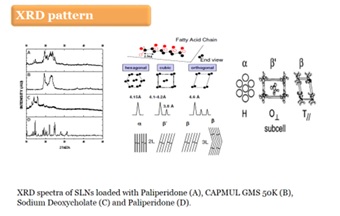
Recent Publications
1. Jaspreet Kaur Randhawa, (2013) High melting lipid based approach for drug delivery: Solid lipid nanoparticlesMaterials Science and Engineering: C, , 33, 1842-1852.
2. Jaspreet Kaur Randhawa(2013) Preparation and characterization of Paliperidone loaded solid lipid nanoparticles, Colloids and Surfaces B: Biointerfaces, , 102, 562-568.
3. Jaspreet Kaur Randhawa (2014) Paliperidone-loaded spherical solid lipid nanoparticles RSC Advances, 4, 30186-30192.
4. Jaspreet Kaur Randhawa (2015) RSC Advances, , 5, 68743-68750.
5. Jaspreet Kaur Randhawa (2017) Curcumin encapsulated zeolitic imidazolate frameworks as stimuli responsive drug delivery system and their interaction with biomimetic environment, 7:12598.
Valerio F Gili
Paris Diderot University, France
Title: High-contrast monolithic photonic nanostructures in the AlGaAs-on-insulator platform
Time : 14:55-15:15
Biography:
VALERIO F. GILI went to the University of studies of Rome “La Sapienza”, where he studied Physics and took his bachelor degree in 2012. He received the Master degree in Physics at the University of studies of Rome in 2014, doing an experimental thesis on quantum optics with Paolo Mataloni and Fabio Sciarrino. He now attends PhD. Study in the Laboratoire Matériaux et Phénomènes Quantiques at Paris Diderot University.
Abstract:
Aluminium gallium arsenide (AlGaAs) is a promising material for monolithic photonics. Besides having a high optical Kerr coefficient, this III-V semiconductor alloy has a high ; it is a mature laser material; and its direct band-gap can be varied with the Al molar fraction, making it not only linearly transparent from 0.7 µm to 16 µm, but also two-photon-absorption free at 1.55 µm. Several types of AlGaAs high-contrast nonlinear integrated photonic structures have been demonstrated in the last years, spanning from nanowires [1,2] to high- resonators [3,4] and multi-pole nanoantennas [5]. To confine photons at sub-wavelength scales, such devices rely on a high-refractive-index core clad by a far lower index in two or three dimensions, and therefore they typically consist of semiconductor nanostructures that either lie on an oxide substrate or are suspended in air. Here we focus on the former case, which seems more promising because of its superior heat-sink behaviour and mechanical stability. Our devices, from the nano- to the micro-scale, share the same fabrication protocol: they are grown by molecular-beam-epitaxy on {100} non-intentionally doped GaAs wafer, with a few hundred nanometres layer of Al0.18Ga0.82As on top of an aluminium-rich substrate, to be oxidized at a later stage (see Figure 1). In order to improve the eventual adhesion between AlOx and the adjacent crystalline layers, such substrate consists of AlAs layer of about 1μm of thickness sandwiched between proper matching layers. A number of nonlinear optics results have been allowed by this class of devices, ranging from second harmonic generation to down-conversion in optical nanoantennas, and from radiation pattern engineering with subwavelengths photonic molecules to frequency conversion in waveguides and resonators. We will provide an overview of this new and exciting research field, along with a few perspectives.
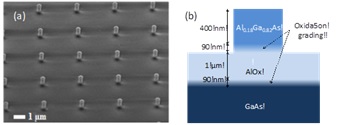
Fig. 1: Monolithic AlGaAs-on-AlOx nanoantennas: (a) scanning-electron-microscope picture of a part of the array; (b) schematics of a single nanoantenna.
Recent Publications
1. Scaccabarozzi L et al. (2009) Enhanced second-harmonic generation in AlGaAs/AlxOy tightly confining waveguides and resonant cavities. Opt. Lett. 31: 3626-3629.
2. Morais N et al. (2017) Directionally induced quasi-phase matching in homogeneous AlGaAs waveguides. Opt. Lett.
3. Mariani S et al. (2014) Second-harmonic generation in AlGaAs microdisks in the telecom range. Opt. Lett. 39: 3062-3065.
4. Pu M et al. (2016) Efficient frequency comb generation in AlGaAs-on-insulator. Optica 3: 823-826.
5. Gili V F et al. (2016) Monolithic AlGaAs second-harmonic nanoantennas. Opt. Express 24: 15965-15971.
Golibjon R. Berdiyorov
Hamad bin Khalifa University, Qatar
Title: First-principles study of optoelectronic, transport and ionic sieving properties of Ti3C2X2 (X=O, OH and F) Mxene
Time : 15:50-16:10

Biography:
Golibjon Berdiyorov is a Scientist in Qatar Environment and Energy Research Institute, Hamad Bin Khalifa University. He has an experience in performing theoretical investigations on structural, optoelectronic and transport properties of molecular and low-dimensional systems. Currently, he is interested in conducting material science research with a focus on predicting novel materials for photovoltaics, energy storage applications and membranes materials for water treatment. In his studies he mostly uses first principles methods (such as Density Functional theory in combination with the non-equilibrium Green’s function formalism) and other atomistic scale methods such as force field based molecular dynamics. He has published more than 100 research articles, which have already received more than 1600 citations. He was awarded for his research including the best research award at University of Antwerp.
Abstract:
MXenes, a new family of low-dimensional materials, have received a lot of interest due to their unique physical, chemical, and mechanical properties [1]. MXenes have already shown a great potential in storage applications due to their impressive capacitive performance [2]. Here, we study the electronic and transport properties of Ti3C2 MXene using density-functional theory (DFT) in combination with the nonequilibrium Green’s function formalism [3, 4]. Fluorinated, oxidized and hydroxylated surfaces are considered. We found that the surface termination has a considerable impact on the electronic transport [3]. For example, the fluorinated sample shows the largest transmission, whereas surface oxidation results in considerable reduction of the electronic transmission. Such enhanced transmission originates from the extended electronic states and smaller variations of the electrostatic potential proï¬le. We also study the effect of lithium and sodium ion adsorption on the electronic transport properties of the MXene [4]. Optical properties of MXene are also affected bysurface functionalization [5]. For example, in the visible range of the spectrum, the oxidized sample shows larger absorption, whereas surface fluorination results in weaker absorption as compared to pristine MXene.
Recently, MXene nanosheets have also emerged as ultrathin and high-flux sieving membranes [6]. In addition to ultrafast water flux, both hydration radius and charge dependent transport of ions have been observed. MXenes are also shown to be highly resistive to biofouling [7]. Here we present the results of our DFT calculations to explore the possible mechanisms for the charge-selective ionic transport through Ti3C2X2 (X=O, OH or F) Mxene [8, 9]. We show that the charge selectivity originates from the charged nature of the MXene layers: the system shows dynamic response to the intercalating ions, even in their hydrated states, by changing the interlayer spacing. We also address the stability of MXene membranes and discuss the possibilities of enhancing their stability by molecular and nanoparticle intercalations. We present the results of our atomistic scale calculations for structural, electronic water sieving properties of hydrophobic graphene and hydrophilic MXene monolayers (see Fig. 1).

Fig 1. Atomistic structure of graphene (top) and Ti3C2(OH)2 MXene (bottom) bilayer with intercalating water molecules.
Recent Publications
1. M. Naguib, V. N. Mochalin, M. W. Barsoum, Y. Gogotsi, 25th Anniversary Article: MXenes: A New Family of Two-Dimensional Materials, Adv. Mater. 26, 992 (2014).
2. J.-C. Lei, X. Zhang, Z. Zhou, Recent advances in MXene: Preparation, properties, and applications, Front. Phys. 10, 276 (2015).
3. G. R. Berdiyorov, Effect of surface functionalization on the electronic transport properties of Ti3C2 MXene, Europhys. Lett. 111, 67002 (2015).
4. G. R. Berdiyorov, Effect of lithium and sodium adsorption on the electronic transport properties of Ti3C2 MXene, Appl. Sur. Scie. 359, 153 (2015).
5. G. R. Berdiyorov, Optical properties of functionalized Ti3C2T2 (T = F, O, OH) MXene: First-principles calculations, AIP Advances 6, 055105 (2016).
6. C. E. Ren, K. B. Hatzell, M. Alhabeb, Z. Ling, K. A. Mahmoud, Yury Gogotsi, Charge- and Size-Selective Ion Sieving Through Ti3C2 T x MXene Membranes, J. Phys. Chem. Lett. 6 (2015) 4026-4031.
7. K. Rasool, K. A. Mahmoud, D. J. Johnson, M. Helal, G. R. Berdiyorov, and Y. Gogotsi, Efficient Antibacterial Membrane based on Two-Dimensional Ti3C2Tx (MXene) Nanosheets, Scientific Reports 7, 1598 (2017).
8. G. R. Berdiyorov, M. E. Madjet, and K. A. Mahmoud, Ionic transport through Ti3C2(OH)2 MXene: ï¬rst principles calculations, Applied Physics Letters 108,113110 (2016).
9. G. R. Berdiyorov and K. A. Mahmoud, Effect of surface termination on ion intercalation selectivity of bilayer Ti3C2T2 (T=F, O and OH) Mxene, Applied Surface Sciences 416, 725-730 (2017).
Gennady N Panin
IMT RAS, Russia / NITA, Dongguk University, South Korea
Title: Memristive nanostructures based on 2D crystals
Time : 16:10-16:30

Biography:
Gennady N. Panin (Ph.D.) is a professor at the Academy of Nanotechnologies (NITA), the Department of Physics at Dongguk University and a senior research fellow at the Institute of Microelectronic Technology of the Russian Academy of Sciences (IMT RAS). He graduated from the Moscow National University with a degree in Applied Physics and Electronics with honors and received his doctorate in physics of semiconductors and solid state electronics at the IMT RAS in 1994. He worked as a research fellow at the Institute of Solid State Physics, Halle, Germany, in 1986 and at the Faculty of Physics of Materials at the University of Complutense, Madrid, Spain, in 1994-1996 and as a research professor (2000-2008), Professor ( 2008-2017), Vice-Director (2012-2017) of QSRC at Dongguk University, Seoul. His research interests include the physics of quantum structures and multifunctional nanomaterials based on layered multiferroics and graphene to create new photonic and electronic devices for use in nano-information technologies.
Abstract:
Statement of the Problem: Memristive systems based on two-dimensional (2D) crystals such as graphene, graphene oxide, molybdenum disulphide, etc., 1-5, are considered as a new type of electronic elements with extremely low energy consumption and with ultra-high scalability for processing and storage of information. The unique electronic and optical properties of 2D crystals demonstrate the enormous potential for creating ultra-high density nano-and bioelectronics for innovative imaging systems. The purpose of this study is to develop memristors with a floating photogate so-called photomemristors2,3 based on graphene and nanocrystals. Findings: A new concept of the formation of self-assembled nanoscale photomemristive heterojunctions of graphene, graphene oxide and zinc oxide in the form of two-terminal memristors with a floating photogate for bioelectronics and optoelectronics is demonstrated. Methodology & Theoretical Orientation: Photocatalytic oxidation of graphene with nanocrystals of zinc oxide is proposed as an effective method of creating two-dimensional memristive systems with photoresistive switching for synaptic nonvolatile memory of ultrahigh density. Conclusion & Significance: Two-dimensional photomemristive systems with a floating photogate exhibit multiple states controlled in a wide range of electromagnetic radiation, and can be used as neurohybrid systems for neuromorphological calculations, image processing, and pattern recognition needed to create artificial intelligence.

a - Schematic electronic diagram of the G/ZnO NP interface under UV irradiation. Electron-hole pairs generated in ZnO (3.3 eV) under UV irradiation (reaction 1) are separated by a built-in electric field at the G/ZnO NP interface, providing a flow of holes into the graphene; b - resistive states of the G/GO photomemristor, which are switched by the Set/Reset voltage of -3.8/3.3 V in the dark and -3.5/4 V with light pulses and read at 2.5 V.
Acknowledgements
This work was supported by Basic Science Research Program through the NRF of Korea funded by the Ministry of Education (No. 2017R1D1A1B03035102).
Recent Publications
1. Gennady N. Panin et al (2011) Resistive Switching in Al/Graphene Oxide/Al Structure. Jpn. J. Appl. Phys. 50:070110
2. Olesya O. Kapitanova, Gennady N. Panin et al (2017) Formation of Self-Assembled Nanoscale Graphene/Graphene Oxide Photo-memristive Heterojunctions using Photocatalytic Oxidation. Nanotechnology 28:204005.
3. Wei Wang, Gennady N. Panin et al (2016) MoS2 memristor with photoresistive switching. Scientific Reports 6:31224.
4. Wei Wang, Olesya O. Kapitanova, Pugazhendi Ilanchezhiyan, Sixing Xi, Gennady N. Panin, Dejun Fu, Tae Won Kang (2018) Self-assembled MoS2/rGO nanocomposites with tunable UV-IR absorption. RSC Advances 8:2410.
5. Xiao Fu, P. Ilanchezhiyan,a G. Mohan Kumar, Hak Dong Cho, Lei Zhang, A. Sattar Chan, Dong J. Lee, Gennady N. Panin and Tae Won Kang (2017) Tunable UV-visible absorption of SnS2 layered quantum dots produced by liquid phase exfoliation. Nanoscale 9:1820.
